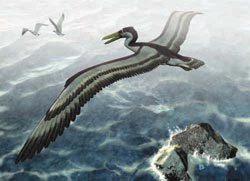Mother of a Goose! – Giant ocean-going geese with bony-teeth once roamed across SE England

Artists reconstruction of a giant pseudo-toothed bird. Picture credit Ludger Bollen, from \"Der Flug des Archaeopteryx\", Quelle+Meyer Vlg.<br>
It may be a few weeks until the British pantomine season kicks-off, but this new fossil from the Isle of Sheppey is giving 'Mother Goose' an entirely new meaning.
Described today (September 26) by Gerald Mayr, Senckenberg Research Institute and Natural History Museum, in the journal Palaeontology, the skull belongs to Dasornis, a bony-toothed bird, or pelagornithid, and was discovered in the London Clay, which lies under much of London, Essex and northern Kent in SE England. The occurrence of bony-toothed birds in these deposits has been known for a long time, but the new fossil is one of the best skulls ever found, and preserves previously unknown details of the anatomy of these strange creatures.
With a five metre wingspan, these huge birds were similar to albatross in their way of life. Albatross have the largest wingspan of any living bird, but that of Dasornis was over a meter and half greater. Despite these similarities, the latest research suggests that the closest living relatives of Dasornis and its fossil kin are ducks and geese.
“Imagine a bird like an ocean-going goose, almost the size of a small plane! By today's standards these were pretty bizarre animals, but perhaps the strangest thing about them is that they had sharp, tooth-like projections along the cutting edges of the beak” explains Gerald Mayr, expert palaeornithologist and author of the report. Like all living birds Dasornis had a beak made of keratin, the same substance as our hair and fingernails, but it also had these bony 'pseudo-teeth' “No living birds have true teeth – which are made of enamel and dentine – because their distant ancestors did away with them more than 100 million years ago, probably to save weight and make flying easier. But the bony-toothed birds, like Dasornis, are unique among birds in that they reinvented tooth-like structures by evolving these bony spikes.” So why did Dasornis have these pseudo-teeth? “Its linked to diet” says Mayr, “these birds probably skimmed across the surface of the sea, snapping up fish and squid on the wing. With only an ordinary beak these would have been difficult to keep hold of, and the pseudo-teeth evolved to prevent meals slipping away.”
Notes to Editors:
1. The paper, “A skull of the giant bony-toothed bird Dasornis (Aves: Pelagornithidae) from the Lower Eocene of the Isle of Sheppey” by Gerald Mayr is published in the September 26th issue of Palaeontology. Copies of the paper can be obtained on request from Doris von Eiff (details below).
2. Gerald Mayr is scientist at the Senckenberg Research Institute and Natural History Museum, Frankfurt/Main, Germany.
3. Larger images of the following pictures can be obtained from Doris von Eiff (details below).
4. The fossil belongs to the collection of the Karlsruhe Natural History Museum
5. Palaeontology is published by the Palaeontological Association, a registered charity that promotes the scientific study of fossils. It is one of the world's leading learned societies in this field. For further information about the Association and its activities, or forthcoming papers of interest in Palaeontology, contact the Publicity Officer, Mark Purnell, publicity@palass.org
Issued by: Forschungsinstitut und Naturmuseum Senckenberg, Senckenberganlage 25, 60325 Frankfurt am Main, Germany
Contact: Gerald Mayr
gerald.mayr@senckenberg.de
+49 69 7542 1348
Press Contact: Doris von Eiff, Press Officer
doris.voneiff@senckenberg.de
+49 69 7542 1257
+49173 54 50 196
Weitere Informationen:
http://www.senckenberg.de/root/index.php?page_id=662
http://www.senckenberg.de/root/index.php?page_id=982
http://www.palass.org
http://www.sheppeyfossils.com
Media Contact
More Information:
http://www.senckenberg.deAll latest news from the category: Life Sciences and Chemistry
Articles and reports from the Life Sciences and chemistry area deal with applied and basic research into modern biology, chemistry and human medicine.
Valuable information can be found on a range of life sciences fields including bacteriology, biochemistry, bionics, bioinformatics, biophysics, biotechnology, genetics, geobotany, human biology, marine biology, microbiology, molecular biology, cellular biology, zoology, bioinorganic chemistry, microchemistry and environmental chemistry.
Newest articles

A Job Well Done: How Hiroshima’s Groundwater Strategy Helped Manage Floods
Converting Disasters into Opportunities Society is often vulnerable to disasters, but how humans manage during and after can turn devastation into opportunities for improved resilience. An Alternative Water Source: Private…

Shaping the Future: DNA Nanorobots That Can Modify Synthetic Cells
Scientists at the University of Stuttgart have succeeded in controlling the structure and function of biological membranes with the help of “DNA origami”. The system they developed may facilitate the…

At What Cost? Smoking Linked to Decreased Earnings, Less-Educated Workers
A new paper in Nicotine & Tobacco Research, published by Oxford University Press, finds that smoking has a negative effect on earnings among younger workers. This is particularly true among the…



